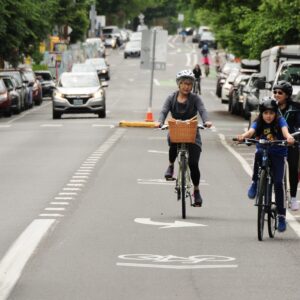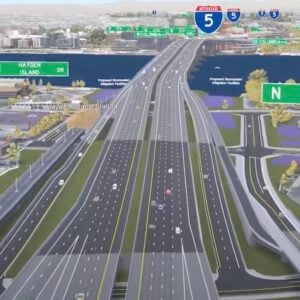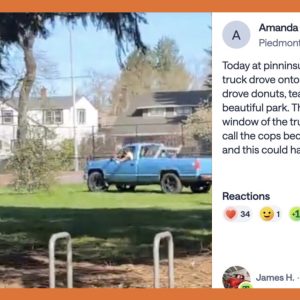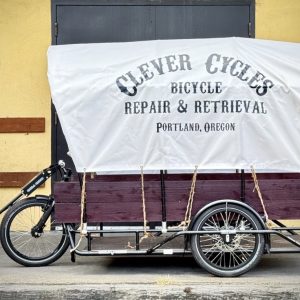Spencer Boomhower, the Portland-based video game animator and livable streets advocate who created the definitive videos about the case for letting people on bikes treat stop signs as yield signs and the insanities of the Columbia River Crossing freeway expansion, is at it again.
Boomhower’s foray into the business of urban planning visualization, Cupola Media, just teamed up with Massachusetts-based walkable-streets author and consultant Jeff Speck to create a series of simple looping Vine videos that illustrate one of the simplest principles of modern transportation planning: the fact that we can make a lot of big improvements to our streets using nothing but paint.
Above is their illustration of the “classic American road diet.” Here are the others they’ve made so far:
Advertisement
Boomhower and Speck have also created some short Vimeo videos that do the same thing. Cupola’s Vine page also includes versions without the voiceover.
Some quibbles could be raised here. Most U.S. bikeway designers are not in favor of 2-way protected bike lanes on 2-way streets, like the ones shown in illustration #3, because of the intersection conflicts they create. (The video clip alludes to protected intersections, but those aren’t nearly as cheap or easy to install as a bike lane.) And 4 feet in each direction is really not much space for comfortable two-way bike traffic, even with a buffer.
In any case, what’s important about these videos is how they strip away the emotional minefield of a bikes-versus-cars narrative and focus on the essential fact here: it’s really easy to repaint streets in ways that make them safer for people driving, walking and biking. Let’s hope these guys keep finding ways to make that idea obvious to more of us.





Thanks for reading.
BikePortland has served this community with independent community journalism since 2005. We rely on subscriptions from readers like you to survive. Your financial support is vital in keeping this valuable resource alive and well.
Please subscribe today to strengthen and expand our work.
Great videos, Jeff and Spencer!
Two suggestions for future iterations, if at all possible:
– Don’t call them cycle tracks. No one in the general public knows or likes the term – it’s confusing plannerese. Call them separated bike lanes (which polls slightly better and is consistent with FHWA language) or protected bike lanes (which advocates have been using).
– Add in animation of turning cars. I imagine that’d be a lot of work, but showing the clogging up of traffic on existing four-lane roads due to turning cars (and the benefit of the center turn lane) really highlights the benefits to drivers.
Thanks Evan! Really appreciate it.
The call on wording went to Jeff, who wrote his own voiceover. But I didn’t disagree with “cycle tracks”. It’s what I learned to call them, and it seems like members of the general public _should_ be able to get their heads around the term even if it’s unfamiliar at first. And it has fewer syllables. Having had to do voiceover in the past, I appreciate fewer syllables, especially for a term that’s repeated a lot. It’s like with “people on bicycles” – I know that’s the preferred term, but sometimes I settle for “cyclist,” or maybe “bike rider.” Plus, NACTO calls them cycle tracks:
http://nacto.org/publication/urban-bikeway-design-guide/cycle-tracks/
Though maybe those are just the people we’d expect to engage in confusing plannerese. 🙂
And turning cars would be really effective, I agree. It’s not hugely difficult, but time was of the essence, and having everything moving in uncomplicated and predictable paths (i.e. a straight line parallel with every other path, set to infinite loops) makes everything so much easier.
I’m pretty sure NACTO is going to switch to “protected” or “separated” in its next edition. The empirical case against “cycle track” is pretty overwhelming, at least to my eyes. Also it’s just a confusing name that implies, if anything, the opposite of what a protected/separated bike lane is, which is a relatively slow-moving route designed for nonathletes. When the main obstacle to people understanding a concept is that they haven’t been exposed to it in real life, but the only way to become exposed to it is for the public to agree to build it, then people do not gradually come to understand the concept. They just never build it.
In this situation, nobody understanding what a phrase means is a much bigger problem than the number of syllables.
Just my (strongly held) opinion.
When I’ve polled my non-planner friends, they overwhelmingly think a “cycle track” is some kind of velodrome. The word “track” implies a circular track, like a race track or running track. And the word “cycle” has negative connotations, making people think of spandex-clad recreational cyclists. “Protected Bike Lane” or “Separated Bike Lane” are the best terms to use.
“…– Don’t call them cycle tracks. No one in the general public knows or likes the term…” Evan Manvel
There’s an accomplishment: the public somehow being able to not like a term it doesn’t know.
I’ve encountered plenty of people that aren’t familiar with what cycle tracks in cities are. After sharing a few bits of information about cycle tracks, the response runs more along the lines of: ‘Oh…there’s a need for something like that.’. They don’t say: ‘Can’t stand that term, first thing they ought to do is change it to something else.’.
Possibly, it’s not a commonly understood term, because very few cycle track project proposals have been put before the broader public for discussion.
Actually, that’s pretty much standard human behavior: fear of the unknown.
Or at least people think less favorably of things they don’t have any idea what they are than they do of things they can picture, like separated bike lanes.
If you have to explain the term terms you use, you’re losing half the public before the discussion has even started.
Gotta love a world filled with 1948 Plymouths and Schwinn cruisers
Exactly what I’d expect a person named “Granpa” to say. 😉
I have issues with the first image…
it’s not a road diet, it’s a lane reconfiguration… it doesn’t go from 4 lanes to 3, it goes from 4 lanes to 5… bike lanes are lanes…
also, nobody disputes that cars continue to drive on the road (“does not reduce car counts”), it’s the extra time that it takes due to more condensed traffic… can they accurately say “does not reduce driving time”? that’s what drivers care about…
also, it shows a street with very little use… easy to accept an under-used street getting redesigned…
…
as for the others… why is safety only mentioned in one? I don’t like that they allude to paint being protection…
Yeah. I agree with what is trying to be said, but I don’t the illustration as it currently exists conveys the idea that the impact of road diets on auto mobility is actually far less than everyone thinks it will be. Maybe showing traffic stacking up from left turns in the four-lane configuration, and moving more freely with a center left-turn lane instead???
The effect on auto traffic is a function of the current level of traffic. As depicted – low volume, the effect is minimal.
NW/SW 3rd is about to have an auto lane converted to buffered bike lane. The modeling showed that queue length would increase from half a block to a block, or a block and a bit. Drivers notice longer queues. The modeling also indicated that all the queued traffic could still get through the signal with the current timing – something the people driving may not notice.
“…I don’t like that they allude to paint being protection… ” Spiffy
Will many people not already riding due to reservations over having to ride directly next to motor vehicle traffic, be sufficiently reassured by road paint treatments to bike lanes (buffers and modestly raised road surfaces.), to have them decide to start riding?
Maybe…it would be nice if they were.
I don’t appreciate being used as traffic calming by being given unsafe bike lanes.
You mean like on SE 26th?
SE 26th is not fun to ride on, being a three-foot lane sandwiched between moving cars and parked cars. But seeing as it was installed before protected bike lanes really got started, it gets a pass. Long-term goal should be to improve 26th with protected bike lanes and intersections.
Using sub-standard bike lanes to create a road diet is a backwards approach. We should design the safest possible bike lane (i.e. curb-side cycle tracks) to encourage people to actually use the new bike lanes, then base the lane reduction on how much space is needed for this.
When door-zone bike lanes are used in road diets as traffic calming without any regard to the people using them, it creates a hazardous situation and unnecessary conflict. What those videos don’t show you is people driving in the bike lane to turn right, people driving though the bike lane to park, and bus drivers driving though and stopping in the bike lane to pick up passengers.
Don’t use us as traffic calming. We deserve better.
Adam,
Define ‘unsafe’.
In the door zone. In a position that requires people to drive though to park and bus drivers to drive through to pick up passengers. Built without any physical separation from car traffic.
How is that an unsafe bike lane? It meets standards.
The standards are unsafe.
That is EXACTLY the change in street configuration of SE Hawthorne that the BTA proposed in the early 90’s, and which was rejected by PBOT in the late 90’s during the Hawthorne Blvd. planning process.
Hawthorne desperately needs bike lanes to calm it…
Not just door-zone bike lanes though. We need curb-side protected bike lanes with protected intersections.
This will never happen in our lifetimes, so my vote is for painted lanes or sharrows now rather than nothing at all.
Not with that attitude.
So get off your computer and do something about it. Adam for Mayor.
I put in my time for over a decade, but I’m retired from bicycle advocacy now, and I never want to attend another public meeting about it again.
The space requirements depicted in the protected intersection concepts – right of way widths – are very uncommon in Portland except on major roads.
Assuming you are providing for at least one lane of car travel in each direction.
I once thought that and all it took was the political winds to change and they started building some. Keep requesting what is wanted and someday it will happen.
Totally agree that SE Hawthorne has some great possibilities that are not being realized. I think it can be done easily too.
No kidding. Even as a driver, it would be a huge improvement.
Would still love to get a streetcar down it while we’re at it, but I suppose I can keep dreaming eh?
^The first animation
Maybe the thinking at PBOT has changed since the early 90s. Portland was a very different city then, and PBOT (or PDOT as it was then called) was still quite conservative.
Engineers in general are conservative.
The largest motor vehicles have a door zone that extends twelve feet from the curb when legally parked and further when they park illegally far from the curb as they are wont to do. A door zone extending eleven feet from the curb is quite common. The road diet shown puts in bike lanes that have their edge a mere thirteen feet from the curb with on-street parking. That leaves one to two feet of bike lane, including the stripe, that is clear of the door zone.
Frankly, I’d rather have the four lane pre-diet configuration than the door-zone bike lane one. And yes, I did indeed teach my child to take the lane on such roads back when he was six years old. The beauty of riding with children is that motorists are much less aggressive around them. Ditto for riding with my elderly parents.
“…That leaves one to two feet of bike lane, including the stripe, that is clear of the door zone. …”
Within that “one to two feet of bike lane, including the stripe, that is clear of the door zone” is where people riding should establish their line of travel on sections of the street where cars are parked.
Depicted in an animation video such as these, how might people invited to watch the video, react to seeing a video figure riding and using this strategy for avoiding the door zone?
Of course, on standard width and narrower bike lanes, using this strategy carries with it another risk: passing cars being closer to the person riding than if the center of the bike lane was used, as shown in the video. Decisions, decisions… . If I have to, I’ll choose to risk a glancing impact from a passing vehicle (hopefully no worse than that.) rather than riding where it may mean smacking right into an opening vehicle door.
Spencer…the concept and production values of those videos, is slick. Makings of a powerful tool. Some videos showing people properly (with signals and sufficient advance from approaching vehicles.) transitioning from bike lane to main lane and back, would also be interesting.
I do not like the idea of creating 2-way, isolated bike lanes on one side of the street. This creates tricky, dangerous conditions entering and exiting the facility. IT also creates miserably skinny, 4-foot bike lanes. I do not relish the thought of trying to get around town stuck behind a bunch of pokey cyclists, nor do I relish the idea of being that pokey cyclist. I think facility would be a real turn-off to a new cyclist, and unappealing to the more confident riders.
These are precisely the reasons why two-way cycle tracks have fallen out of favor in international standards. Better to install two one-way cycle tracks on each side of the street.
You might want to stop using the term “cycle track” if you want the general public to support them. It’s a meaningless term to most people, or at worst implies some kind of race track for racing bikes, like a velodrome. Call them “protected bike lanes” and people will know intuitively what you’re talking about.
Montrealers would disagree. Those types of facilities rule that city and with zillions of bikes.
#4 makes me think of SE Belmont for some reason…
Thanks for posting, Michael! Fun to see these out in the world.
And lots of good feedback coming in, much appreciated.
What I don’t like about these bike lanes (not the protected ones) is that they’re right in the dooring zone. I don’t mind unprotected bike lanes, but they’ve just gotta be safely away from parked cars.
Can we put the paint down on foster already.